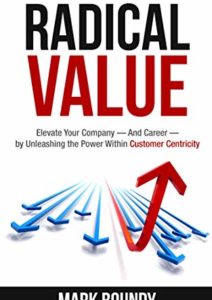I can’t think of any concepts more misunderstood than price, pricing, and discounting. An alarming number of businesses price poorly. We even teach falsehoods about price at the college level. Let’s discuss five myths about pricing, and its Mr. Hyde alter-ego, discounting.
I usually start breathing fire on this topic, so buckle up. If this starts feeling a little too close to home, don’t get mad. Get better.
Myth #1: Price should be related to your costs.
Price should relate to customer value, period. Cost-plus pricing (your costs, plus some margin should equal price) is only useful to set a minimum, or a walkaway, not your actual price.
Take this one question quiz: Your customer wants a price that is below your costs. You tell him so. Question: is the average customer more likely to:
A: Erupt with a sympathetic “Oh, in that case, tell me what you want me to pay!”
B: Let you know, politely or otherwise, that your costs are not his/her problem, and (gently but?) firmly give you some version of “take it or leave it”.
So, if your costs are none of the customer’s business at the low end– and you know it – why should your costs be any of your customer’s business at the high end?
Customers will only pay any price (high or low) voluntarily – at least in the long run. The reason they pay the price they do is that they find sufficient value in the outcomes your offer delivers. Figure out your value, quantify it, and then set your price accordingly.
Myth #2: Dropping your price will increase demand.
This myth is taught in economics classes the world over, up through the college level. Economists build mathematical models using the law of demand. Here’s the catch: The law of demand assumes a few things in order to get the math to work:
- All consumers and all producers have all information about all alternatives at all times – for free, and without effort.
- All buying decisions are made without emotion…buyers are all Dr. Spock-like in a world that still uses money.
- Related to “emotionlessness”, price is merely a number. Offered price does not communicate value to any buyer at any time.
- All products and services are perfect substitutes for each other. They are absolute commodities, with no differences. There is no such thing as differentiation.
- It costs nothing to switch vendors. There are no costs to qualify a vendor, and the human bias toward the status quo does not exist.
- …there are a bunch more but isn’t any one of these good enough to make my point?
Real life example: If your offer’s ROI is often north of 500% at similar clients, a hesitant customer isn’t going to be motivated by price. Discounting is only going to convince your prospect to doubt the numbers. Well, OK…not “only”. There are the financial consequences, too.
Myth #3: Price is just another feature…no more or less important than any other.
My jaw drops every time (yes it’s happened) a sales “professional” says “It’s the company’s job to make money at the price I sold”. Then they wonder why nobody in the company invites them to the grownups’ table.
Psychologically, price is the final comparison against value – (value=desirability of your offer’s differentiation). Therefore, it’s the counterbalance against the value of all the differentiated features. Companies with pricing savvy have proved this for decades, and in many industries – even “commodities” like steel and money.
This is so deeply embedded in the human psyche that price actually communicates value. Buyers look more favorably at high-priced alternatives – assuming there must be a reason for the price. Dropping price perceptually diminishes every other feature in your offer. No other feature can do that kind of damage.
If you’re unable to build value in the customer’s mind for the other features, then, sure…go with myth #3.
Myth #4: You can “make it up on volume”.
The mathematical argument here is that by increasing unit volume at a lower contribution margin, you’ll not only get back to break-even, but get further above it. (if it isn’t going to end up as more profitable, why work harder for the same – or fewer — profit dollars?).
The mathematical argument assumes your fixed costs won’t rise too. Let’s think that through. Say you’re a manufacturing leader and need to double capacity because your company decided to “make it up on volume”. The math assumes that you accomplish twice as much using the same plant, equipment, staff, utility bills, G&A, etc. How many seconds of business school does it take to sniff out the fallacy? Sure, in an infinite universe with infinite possible realities, it must be possible to “make it up on volume” somewhere, but I haven’t seen it anywhere in this dimension.
Here’s some independent research:
- McKinsey & Company analyzed the entire Fortune 1000, and on average, a 1% drop in average price would cause an 8% drop in profit.
- Mara and Roriello, in Harvard Business Review, studied an even larger sample and found a 1% drop in average price would cause a 1 % drop in profit.
So…”make it up on volume” disciples: how much do you discount before down becomes up?
Myth #5: You can discount for “one time”, or for a “limited time”.
This is the myth of the “limited time offer”. Your pricing policy is one of the easiest things to train customers on. No reputable company will really give a discount just once, and everyone knows it. Nowadays, every customer just assumes it. In fact, it’s actually harder to convince a prospect that an offer really is a one-time thing than it is to simply sell the value in the first place. Plus, the easy option is more profitable.
It gets even worse: customers are very hard to “un-train” on a new pricing policy. Once you go into the discounting tar pit, you might only get out as a fossil.
Worst of all: People change employers. When one of your customers gets a job elsewhere, they carry knowledge of your discounting behavior with them. See why it’s a tar pit?
Extra Value Bonus:
Myth #6: If a customer says “Your price is too high”, it must be true.
Whenever somebody took the time to tell me what they think of my price, they signaled that talking about my offer and its price was worth their time. What they are really saying is usually “your value is too low”, or “I don’t understand your value well enough”. The other popular option: “I want your product, but am just checking to make sure I’m not paying any more than I have to.” This is simply a due diligence step, not an actual price issue.
The customers who really think your price is too high don’t even return your calls.
Bottom Line
As I said, if this article started feeling a little too close to home, don’t get mad. Get better. If you want to get better, contact me.
To your success!















































Comments